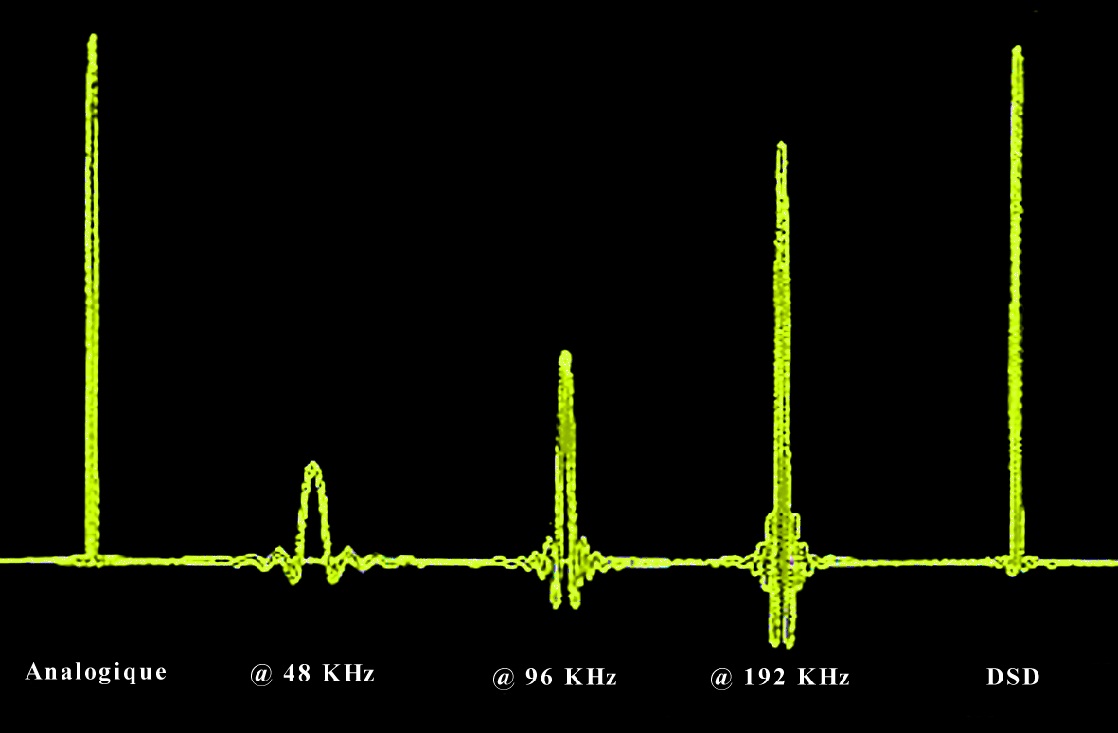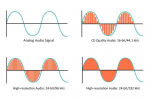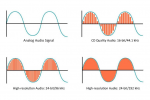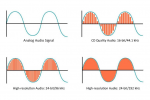ok thanks a lot....
but is higher sample rate ( 96 khz 192 khz) have a better resolution than 44.1 khz to reproduce the 20hz - 20 khz bandwitch ? because when i record at 96 khz with my creamware scope pulsar 2 and my yamaha 01v96 i can hear that i have better treble ?
or maybe it's me who dream having a better sound at 96 khz ?
As the video posted above indicates, digital sampling theory is based on the fact that any frequency can be accurately encoded if the sample rate is high (fast) enough to sample it twice. By "accurate" I mean if you digitally encode, say, a 1kHz signal, it can be decoded - played back - as a 1kHz signal. It will not get played back as a 1.4kHz signal or an 800Hz signal.
This is why you might have noticed that the maximum frequency that can be handled by any sample rate is exactly 1/2 that sample rate, aka the Nyquist limit: since every frequency must be sampled at least twice, your maximum recordable frequency is the sample rate divided by two.
So with that in mind, a 192kHz sample rate can indeed capture more information than a 44.1kHz sample rate - but all that additional information is above the 22.05kHz Nyquist limit (maximum recordable frequency) of a 44.1kHz sample-rate system. And since 22.05kHz is already above the limit of human hearing, the higher frequencies that can be recorded by a 192kHz sample-rate system are inaudible - not "basically inaudible" or "inaudible except to highly trained listeners," but rather totally, by-definition inaudible because human beings simply do not hear those frequencies. In other words, the fact that each frequency needs at least two samples and that higher sample rates capture additional frequencies that are inaudible to us is not an experiential or perceptual rule but rather a mathematical one.
Now, even with this information, there is still a very common question, which is implicit in the idea of "resolution": You might ask, "Okay, fine, but within the 20Hz-20kHz audible range, a 192kHz system samples the sound a lot more than a 44.1kHz system. Couldn't that make the 192kHz system have higher resolution - smoother, more refined, less harsh?"
This is a reasonable question at first glance, but digital sampling is not like analogue recording: once the frequency has been sampled twice, that's it - the accuracy is there and there is no possibility of "more accurate than accurate" in that sense.
Think of it this way: if a higher sample rate created a more refined, smoother, more hi-fi sound, then we would all have a huge problem on our hands with every single piece of digitally recorded music ever produced: no matter what the sample rate is, lower frequency sounds get sampled many more times than higher-frequency ones. Whether it's 44.1kHz or 192kHz or anything else, a 100Hz sound gets sampled literally 100 more times than a 10kHz sound. The lowest string on a guitar will get sampled many more times than the highest string. Male vocals get sampled more times than female vocals. The snare drum gets sampled more than the hi-hat and less than the bass drum. And on and on and on.
Obviously we do not listen to music and think that the bass is much more hi-res than the snare drum on the very same recording.
To put it another way, taking the converse approach: If you sample a 100Hz tone at 192kHz, then at 44.1kHz, and then at, say, 441Hz - in other words 1/100th of the sample rate/"resolution" of 44.1kHz - you will find that the recordings all sound identical.
Digital sampling is a binary proposition: the sample rate either is or is not frequent enough to capture a particular frequency accurately.

 fr.m.wikipedia.org
fr.m.wikipedia.org



